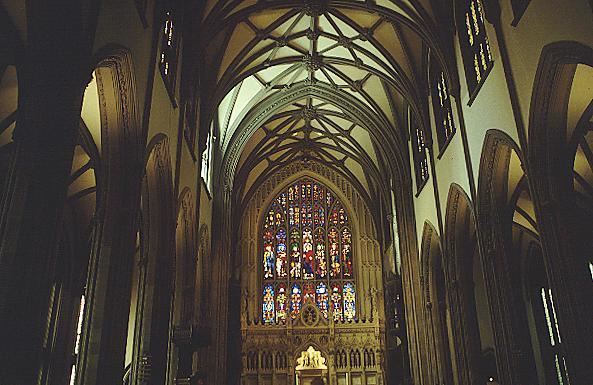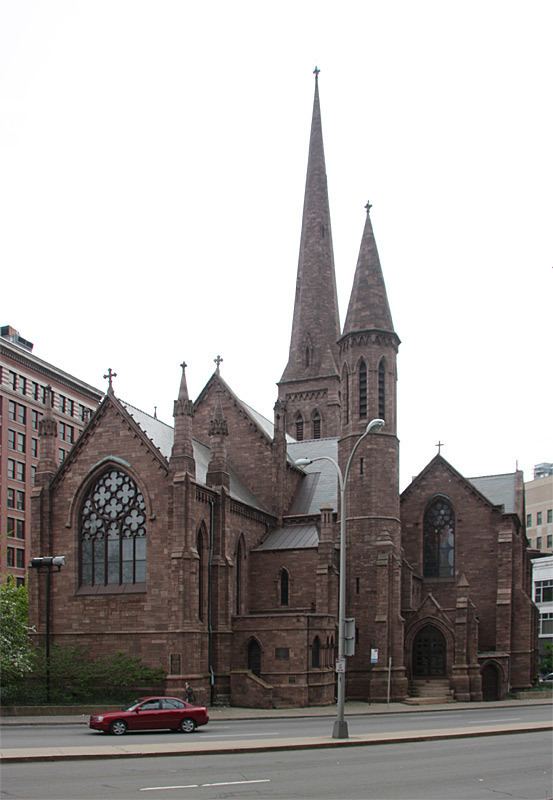Occupation Architect Name Richard Upjohn | Role Architect Children Richard M. Upjohn | |
 | ||
Buildings Trinity Church in New York CityThe Edward King House in Newport, Rhode IslandSt. Paul's Cathedral in Buffalo, New York Books Upjohn's Rural Architecture: Designs, Working Drawings and Specifications for a Wooden Church, and Other Rural Structures Structures Similar People Richard Morris Hunt, Ralph Adams Cram, Jacob Wrey Mould, Stanford White, Frederick Clarke Withers | ||
3 - Gothic Revival - The Architecture Tour
Richard Upjohn (22 January 1802 – 16 August 1878) was a British-born American architect who emigrated to the United States and became most famous for his Gothic Revival churches. He was partially responsible for launching the movement to such popularity in the United States. Upjohn also did extensive work in and helped to popularize the Italianate style. He was a founder and the first president of the American Institute of Architects. His son, Richard Mitchell Upjohn, (1828-1903), was also a well-known architect and served as a partner in his continued architectural firm in New York.
Contents
- 3 Gothic Revival The Architecture Tour
- Adventures in Buffaloland Episode 4 St Pauls Cathedral and Sullivans Guaranty Building
- Life and career
- Veneration
- Projects
- References

Adventures in Buffaloland - Episode 4 - St. Paul's Cathedral and Sullivan's Guaranty Building
Life and career

Richard Upjohn was born in Shaftesbury, England, where he was apprenticed to a builder and cabinet-maker. He eventually became a master-mechanic. He and his family emigrated to the United States in 1829. They initially settled in New Bedford, Massachusetts and then moved on to Boston in 1833, where he worked in architectural design. He became a naturalized citizen of the United States in 1836. His first major project was for the entrances to the Boston Common, the town's central park and his first church would be St. John's Episcopal Church in Bangor, Maine. He had relocated to New York City by 1839 where he worked on alterations to the famed Trinity Church on Wall Street in lower Manhattan. The alterations were later abandoned and he was commissioned to design a new church, completed in 1846, and still extant today. He published his extremely influential book, "Upjohn's rural architecture: Designs, working drawings and specifications for a wooden church, and other rural structures", in 1852. The designs in this publication were widely used across the country by builders, with many examples remaining.
Upjohn, along with 13 other architects, co-founded the American Institute of Architects on February 23, 1857. He served as president of that organization from 1857 to 1876, being succeeded by Thomas Ustick Walter, fourth Architect of the Capitol. He went on the design many buildings in a variety of styles. He died at his home in Garrison, New York in 1878. Architectural drawings and papers by Upjohn and other family members are held by the Drawings and Archives Department of the Avery Architectural and Fine Arts Library at Columbia University, in New York City, also by the New York Public Library's Humanities and Social Sciences Library, in the Manuscripts and Archives division, and by the Library of Congress, Prints & Photographs Division on Capitol Hill in Washington, D.C..
He died on 16 August 1878 in Putnam County, New York of "softening of the brain", (Cerebral Softening).
Veneration
Upjohn is honored together with Ralph Adams Cram and John LaFarge with a feast day on the liturgical calendar in the current 1979 "Book of Common Prayer" of the Episcopal Church in the U.S.A. on December 16.
Projects
Some of Upjohn's notable projects include:
